产品名称
Cleaved-Notch 1 (V1754) Rabbit Polyclonal Antibody
别名
NOTCH1; TAN1; Neurogenic locus notch homolog protein 1; Notch 1; hN1; Translocation-associated notch protein TAN-1
蛋白名称
Neurogenic locus notch homolog protein 1
存储缓冲液
Liquid in PBS containing 50% glycerol, 0.5% BSA and 0.02% New type preservative N.
Human Gene Link
http://www.ncbi.nlm.nih.gov/sites/entrez?db=gene&term=4851
Human Swissprot No.
P46531
Human Swissprot Link
http://www.uniprot.org/uniprotkb/P46531/entry
Mouse Gene Link
http://www.ncbi.nlm.nih.gov/sites/entrez?db=gene&term=18128
Mouse Swissprot No.
Q01705
Mouse Swissprot Link
http://www.uniprot.org/uniprot/Q01705
Rat Swissprot Link
http://www.uniprot.org/uniprot/Q07008
免疫原
The antiserum was produced against synthesized peptide derived from human Notch 1. AA range:1735-1784
特异性
Cleaved-Notch 1 (V1754) Polyclonal Antibody detects endogenous levels of fragment of activated Notch 1 protein resulting from cleavage adjacent to V1754.
稀释度
WB 1:500-2000, IHC-p 1:50-300, IF 1:50-300
宿主
Polyclonal, Rabbit,IgG
背景介绍
notch 1(NOTCH1) Homo sapiens This gene encodes a member of the NOTCH family of proteins. Members of this Type I transmembrane protein family share structural characteristics including an extracellular domain consisting of multiple epidermal growth factor-like (EGF) repeats, and an intracellular domain consisting of multiple different domain types. Notch signaling is an evolutionarily conserved intercellular signaling pathway that regulates interactions between physically adjacent cells through binding of Notch family receptors to their cognate ligands. The encoded preproprotein is proteolytically processed in the trans-Golgi network to generate two polypeptide chains that heterodimerize to form the mature cell-surface receptor. This receptor plays a role in the development of numerous cell and tissue types. Mutations in this gene are associated with aortic valve disease, Adams-Oliver syndrome, T-cell acute lymphoblastic leukemia, chronic lymph
组织表达
In fetal tissues most abundant in spleen, brain stem and lung. Also present in most adult tissues where it is found mainly in lymphoid tissues.
细胞定位
Cell membrane ; Single-pass type I membrane protein .; [Notch 1 intracellular domain]: Nucleus . Following proteolytical processing NICD is translocated to the nucleus. Nuclear location may require MEGF10. .
信号通路
Dorso-ventral axis formation;Notch;Prion diseases;
功能
disease:Defects in NOTCH1 are a cause of aortic valve disease [MIM:109730]. The disorder consists of an early developmental defect in the aortic valve and a later de-repression of calcium deposition that causes progressive aortic valve disease. Calcification of the aortic valve is the third leading cause of heart disease in adults. The incidence increases with age, and it is often associated with a bicuspid aortic valve present in 1-2% of the population.,disease:NOTCH1 truncation is associated with T-cell acute lymphoblastic leukemia.,function:Functions as a receptor for membrane-bound ligands Jagged1, Jagged2 and Delta1 to regulate cell-fate determination. Upon ligand activation through the released notch intracellular domain (NICD) it forms a transcriptional activator complex with RBP-J kappa and activates genes of the enhancer of split locus. Affects the implementation of differentiation, proliferation and apoptotic programs. May be important for normal lymphocyte function. In altered form, may contribute to transformation or progression in some T-cell neoplasms. Involved in the maturation of both CD4+ and CD8+ cells in the thymus. May be important for follicular differentiation and possibly cell fate selection within the follicle. During cerebellar development, may function as a receptor for neuronal DNER and may be involved in the differentiation of Bergmann glia.,PTM:Phosphorylated.,PTM:Synthesized in the endoplasmic reticulum as an inactive form which is proteolytically cleaved by a furin-like convertase in the trans-Golgi network before it reaches the plasma membrane to yield an active, ligand-accessible form. Cleavage results in a C-terminal fragment N(TM) and a N-terminal fragment N(EC). Following ligand binding, it is cleaved by TNF-alpha converting enzyme (TACE) to yield a membrane-associated intermediate fragment called notch extracellular truncation (NEXT). This fragment is then cleaved by presenilin dependent gamma-secretase to release a notch-derived peptide containing the intracellular domain (NICD) from the membrane.,similarity:Belongs to the NOTCH family.,similarity:Contains 3 LNR (Lin/Notch) repeats.,similarity:Contains 36 EGF-like domains.,similarity:Contains 5 ANK repeats.,subcellular location:Following proteolytical processing NICD is translocated to the nucleus.,subunit:Heterodimer of a C-terminal fragment N(TM) and an N-terminal fragment N(EC) which are probably linked by disulfide bonds. Interacts with DNER, DTX1, DTX2 and RBPSUH. Also interacts with MAML1, MAML2 and MAML3 which act as transcriptional coactivators for NOTCH1.,tissue specificity:In fetal tissues most abundant in spleen, brain stem and lung. Also present in most adult tissues where it is found mainly in lymphoid tissues.,
纯化
The antibody was affinity-purified from rabbit antiserum by affinity-chromatography using epitope-specific immunogen.

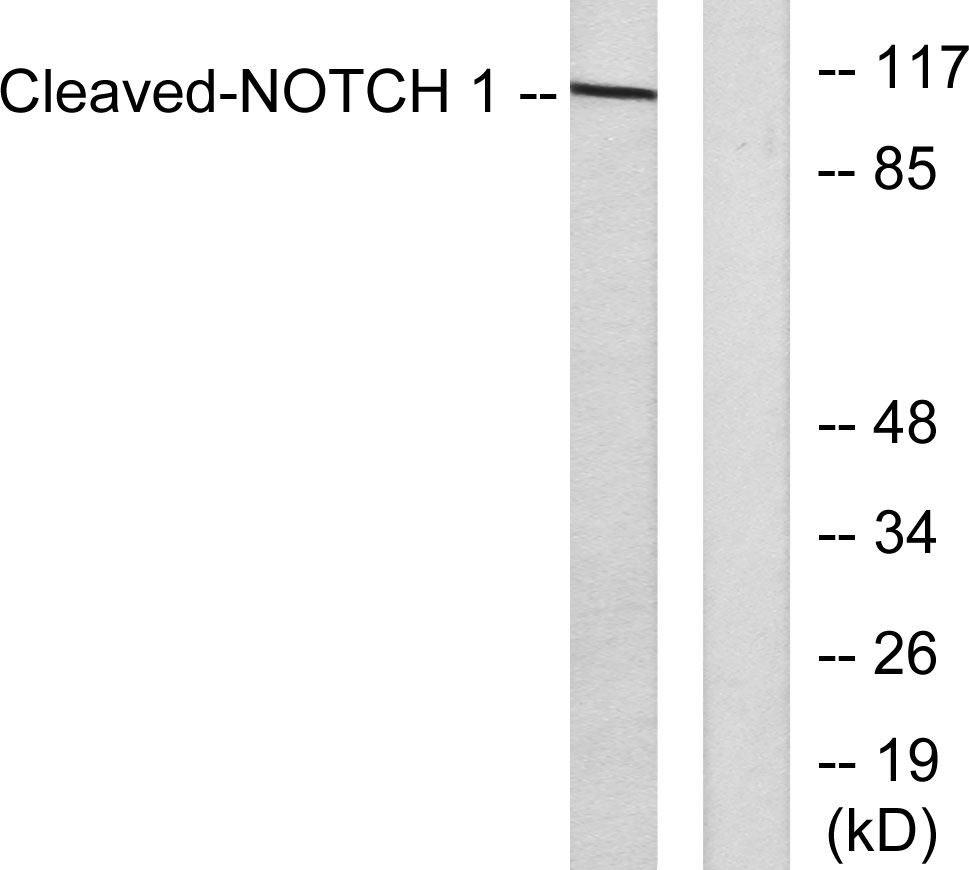
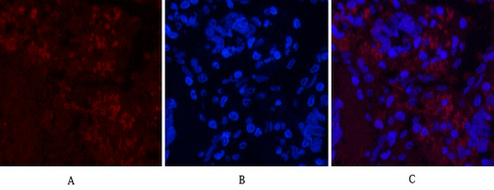
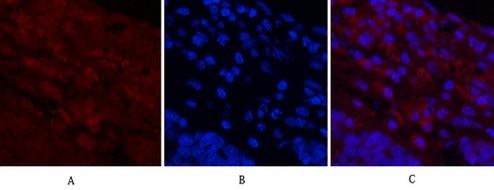
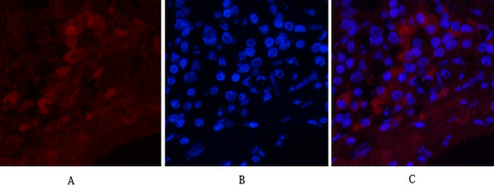
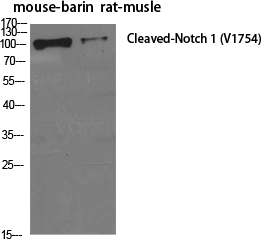
.jpg)
